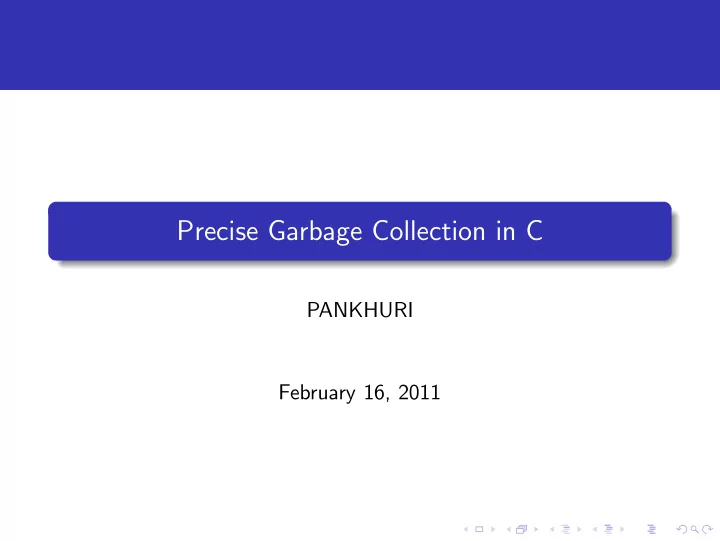

Precise Garbage Collection in C PANKHURI February 16, 2011
Agenda Problem Statement. Precise / Conservative Garbage Collection. What will Magpie do ? C semantics and Precise GC. When will Magpie fail ? Design and Implementation. Results. Conclusion.
GC Algorithms Conservative Numerical Values interpreted as Live Pointers. Mistake dead pointers as root leaving objects in heap indefinitely. Precise Requires exact information about whether a given word is a pointer? Counts references toward reachability only for words: Whose static type is a pointer type. Variables that are in scope.
C Semantics and Precise GC Pointer Manipulation. Pointer arithmetic. Save Pointers? Integer == Pointers ? Pointers == Integer Unconverted Libraries. Will functions save refrences? callbacks ? Explicit Deallocation.
What information GC needs? Which words in the heap are root references? Where references exist in each kind of object? What kind of object each object in the heap is?
Design
Allocation Analysis Determines what kind of object each allocation point creates. Magpie uses this information to tag allocated objects as having a particular type. This tag is used by mark and repair functions to generate appropriate traversal functions.
Structure Analysis Determines which words in an object kind are pointers. Magpie uses this information to generate traversal functions. The mark function is used to traverse a structure or array during the mark phase of a collection. Repair function is used to update pointers when objects are moved.
Call graph analysis Generates a conservative approximation of what functions each function calls. Magpie uses this information to eliminate roots in the local stack.
Tracking local variables Identifies the pointers on the stack and communicates to garbage collector. It performs this communication by generating code to create shadow stack frames on the C stack. Collector traverses them to find the pointers in the normal C stack. There are 4 kinds of frame supported by Magpie: Simple Frame Array Frame Tagged Frame Complex Frame
Stack Frames
Example
Handling Unions When a type contains a union of pointer and non-pointer types,GC need to follow and update a pointer variant only when it is active. The active variant of a union is tracked using an extra byte outside of the object. This byte is set whenever a field of the union is assigned or its address is taken. Mark and repair functions consult the byte to determine whether to follow or repair the pointer variant.
Results Experience with C programs Experience with Linux Kernel.
Conclusion In most cases, Magpie performs within 20 percent (faster or slower) than the original C code . Requires no more effort than the existing Conservative collector. Removes memory spikes created by Conservative GC.
Recommend
More recommend